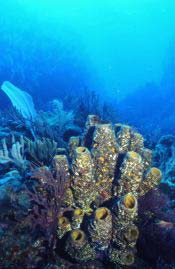Conservationists Identify Marine Biodiversity "Hotspots"

Image: ©Science/Photo by Callum Roberts
Conservation-oriented parks and reserves are fairly common on land, but comparatively few marine regions receive protection from human activities. This situation has, for the most part, elicited little concern, owing to the widely held belief that the large geographic ranges of most marine species would ensure their survival. But new research on restricted-range marine life—that is, species limited to small areas—challenges that idea, identifying 10 regions where further damage to coral reefs could lead to a series of extinctions. According to the authors of a study published today in the journal Science, conservation efforts directed at these so-called hotspots could prevent such extinctions and preserve marine biodiversity.
The researchers, led by Callum Roberts of the University of York, analyzed the geographic distributions of 3,235 different species of reef fish, coral, snail and lobster. More than a quarter of the fish and snail species and more than half of the lobsters have restricted ranges, they report. (Only 7.2 percent of the corals appear to have restricted ranges, but the investigators caution that they may well have underestimated coral biodiversity.) Taking these results into consideration along with those of a previous study, the team identified the ocean’s most threatened reefs and pinpointed the 10 biodiversity hotspots. Although these areas comprise only 0.012 percent of the oceans, they harbor 34 percent of restricted-range species. The researchers note that the Philippines and the Gulf of Guinea are the top two hotspots. Some of the areas might be best served by joint protection plans, as eight of the 10 marine hotspots adjoin terrestrial ones. In these cases, the authors prescribe an extension of conservation efforts from land to sea.
Media Contact
All latest news from the category: Ecology, The Environment and Conservation
This complex theme deals primarily with interactions between organisms and the environmental factors that impact them, but to a greater extent between individual inanimate environmental factors.
innovations-report offers informative reports and articles on topics such as climate protection, landscape conservation, ecological systems, wildlife and nature parks and ecosystem efficiency and balance.
Newest articles

Bringing bio-inspired robots to life
Nebraska researcher Eric Markvicka gets NSF CAREER Award to pursue manufacture of novel materials for soft robotics and stretchable electronics. Engineers are increasingly eager to develop robots that mimic the…

Bella moths use poison to attract mates
Scientists are closer to finding out how. Pyrrolizidine alkaloids are as bitter and toxic as they are hard to pronounce. They’re produced by several different types of plants and are…

AI tool creates ‘synthetic’ images of cells
…for enhanced microscopy analysis. Observing individual cells through microscopes can reveal a range of important cell biological phenomena that frequently play a role in human diseases, but the process of…





















